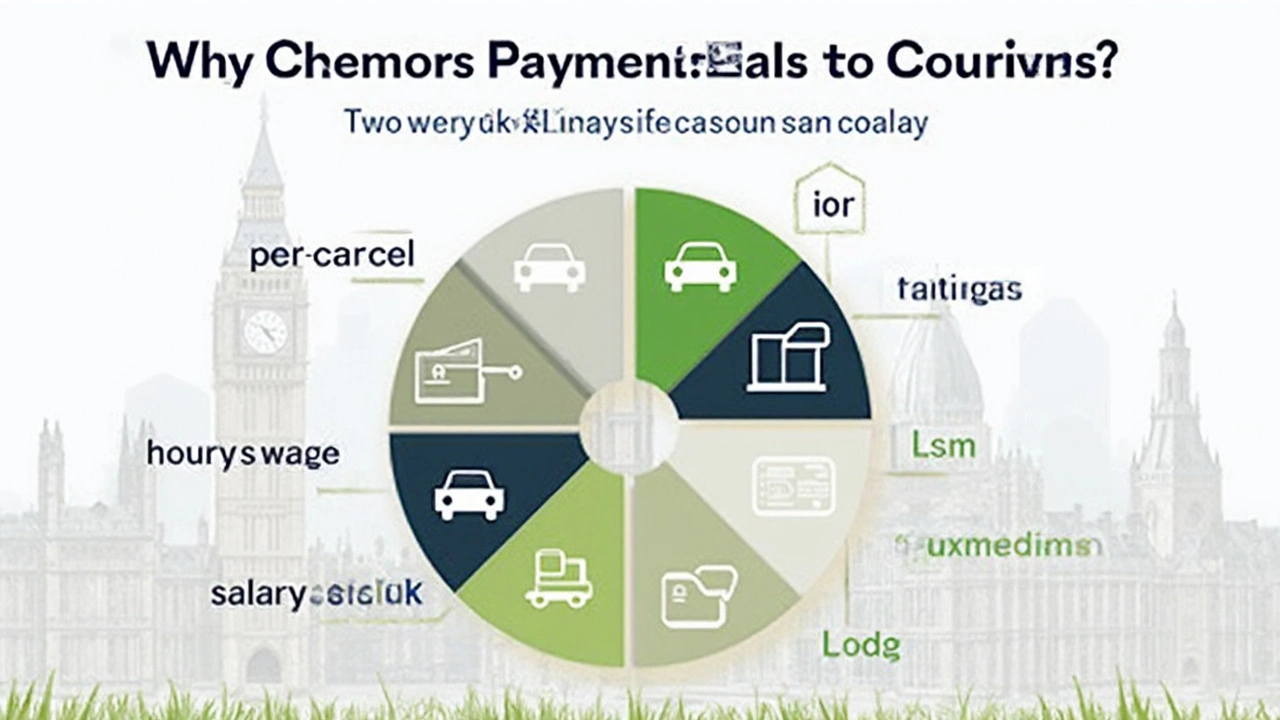Do Couriers Get Paid Per Parcel? Discover the Real Deal

Thinking about becoming a courier or just curious how they get paid? Well, it's a mixed bag, and the answer might surprise you. Some couriers have their earnings tied directly to the number of parcels they deliver, while others might work under different pay structures.
For those paid per parcel, known as piece rate pay, it's pretty straightforward: the more parcels you deliver, the more you earn. This model can be great for folks who hustle hard and know their routes like the back of their hand. However, it also comes with its own set of challenges, like the unpredictability of parcel volume and the pressure to keep up a rapid pace.
- Courier Payment Basics
- Per Parcel Payment Model
- Hourly and Salary Structures
- Impact on Courier Earnings
- Choosing the Right Model
- Tips for Boosting Delivery Income
Courier Payment Basics
So, how do couriers actually get paid? It's not a one-size-fits-all answer, and that flexibility can make things interesting. Most common in the courier world are three payment methods: per parcel, hourly wage, and salary. Each has its perks and pitfalls, and it largely depends on who you're working for and what kind of work you're doing.
Let's talk about the per parcel model first. Most gig economy platforms like Uber Eats and DoorDash often pay couriers for each package or order they deliver. This is great for those who want the potential to earn more by being faster. But, it can also lead to a whole lot of stress if the demand drops or if you run into traffic.
Then there's the hourly wage route. This one's pretty simple – you get paid for the time you're on the clock. It offers steadiness, which is nice, but less incentive to deliver more or find shortcuts.
Finally, some couriers work on a salaried basis, which might come with perks like benefits and job security. Not too shabby if you like consistency in your life!
To give you an idea of how these structures tie into earnings, here's a basic breakdown of what couriers reported making in 2024.
| Payment Model | Average Earnings (NZD) |
|---|---|
| Per Parcel | $1.5 - $3 per parcel |
| Hourly Wage | $20 - $25 per hour |
| Salary | $40,000 - $55,000 per year |
Understanding these payment models is super important for making an informed decision about your courier career, especially if you're eyeing this gig for its flexibility and potential earnings.
Per Parcel Payment Model
The per parcel payment model is like piecework in a factory—you get paid a set amount for each job completed. Pretty straightforward, right? Well, yes and no. This method can work wonders for couriers who love speed and flexibility, but it's got its quirks too.
Most companies using this model offer a fixed rate per package. Picture this: If you're delivering parcels for a popular online retailer, you might earn say $2 per parcel. Not shabby if you're sprinting through 50 parcels a day! But let's be real—this depends a lot on demand, traffic, and even weather conditions.
Here’s a sketch of why this model could work—or crash and burn:
- Pros: High profitability potential if you're delivering during peak time or in a high-density area.
- Cons: Earnings might drop if demand wanes for lengthy periods or routes get tricky.
In some cases, companies adjust the rate based on parcel size or delivery complexity. Bigger boxes and remote spots might give a slight bump in pay, encouraging couriers to take on tougher jobs. Sounds neat, but remember everything's relative! What's a tough job for one courier could be a breeze for another.
Check this out: A 2023 industry snapshot showed that about 60% of gig economy couriers prefer parcel-based pay for the potential to earn big during busy seasons. But it’s not a one-size-fits-all. Enjoying the feel of the wind while tallies climb can be exhilarating, but if you're not up for rapid-fire gigs, it might not be your jam.
Hourly and Salary Structures
When you think about courier jobs, the one-size-fits-all model doesn't really apply. Sure, there's the piece rate, but plenty of couriers earn through hourly or salary structures, offering a bit more stability.
An hourly wage means you're paid for the time you work rather than the number of parcels you deliver. This can be a great setup if your delivery area is particularly busy or if there's lots of traffic causing delays. The upside? Your paycheck doesn't fluctuate wildly day-to-day. You know what you're getting for the hours you log.
For regular, predictable routes or company-employed drivers, a salaried position might be on the table. This means receiving the same amount of money regardless of how hectic or slow delivery days turn out. It's a bit like being on a steady ship amidst rocky waters. A consistent income can ease stress, making it easier to budget and plan your finances.
The courier pay landscape is dynamic, and employers utilize these models depending on the work demands and business needs. For example, during peak seasons, some companies offer a mix—hourly pay with bonuses for extra parcels delivered. This kind of hybrid model keeps motivation high without sacrificing income predictability.
Choosing between hourly, salary, or per parcel pay depends on personal preference and lifestyle. If you're someone who values consistency and has regular expenses like rent, an hourly or salaried approach might align better. But if you thrive in an environment where performance dictates income, then per parcel might still hold appeal.
Delivery earnings aren't just about pay structures; they're also about what works for your life. Weigh these options carefully, consider your needs, and remember that the courier industry often flexes to fit diverse schedules and demands.

Impact on Courier Earnings
Getting paid per parcel has its ups and downs, changing how much a courier makes. One key thing to know is that courier services can vary widely in how they pay, and this directly affects earnings. The piece rate pay model could mean great money during peak times like the holiday season when parcel numbers skyrocket. But, it might be a bit lean when things slow down.
Couriers earning per parcel usually try to deliver as many packages as they can, but factors like traffic, weather, and parcel size can affect speed. For instance, a larger, heavier parcel might take more time and effort compared to a small, light package, which could mean fewer deliveries per hour.
Some companies might offer bonuses or incentives if you hit a certain number of deliveries, adding a bit of a boost to your earnings. This can be a really good motivator for those who are hustling hard, especially when the task feels never-ending.
But what about when it's quiet? That's where the downside kicks in. A courier might find themselves sitting around waiting for parcels to come in, which means, yes, less pay. So, it's smart for couriers to plan their finances to handle these highs and lows.
To give you a sense of the numbers, here's a rough look at how performance might impact earnings:
| Packages Delivered Per Day | Average Daily Earnings (NZD) |
|---|---|
| 20 | $100 |
| 50 | $250 |
| 80 | $400 |
For some folks, per parcel pay works like a charm, especially if they're fast, efficient, and can handle a busy schedule. But for others, a steady hourly or salary setup might be more appealing. Either way, understanding these dynamics helps in choosing what's best for each person's lifestyle and financial goals.
Choosing the Right Model
So, how do you pick the best payment model as a courier? It's about weighing the pros and cons of each option to see what fits your lifestyle and goals. Whether you’re a rookie in the courier world or a seasoned veteran, understanding these models can really make a difference in how much you take home.
If you're considering the per parcel payment model, think about your pace and work style. Do you enjoy a bustling, fast-paced workday where you're on the go and can rely on getting lots of deliveries? Then this might just be a perfect fit. It rewards efficiency and effort, which is awesome if you like setting your own pace. But remember, it might not always provide consistent income since parcel volume can vary.
On the other hand, hourly or salaried positions offer steady pay and might be more your speed if you prefer a predictable schedule. This model is particularly appealing if you're not a fan of the hustle of cramming in as many parcels as possible. You get the advantage of knowing what you’ll earn, regardless of how many deliveries come through.
Ultimately, you need to ask yourself a few questions:
- Do you prefer consistency in your paycheck, or are you okay with earnings that might fluctuate?
- Are you someone who thrives under pressure or do you prefer a more relaxed pace?
- What is your availability like, and how does this fit with potential delivery schedules?
Remember, there’s no one-size-fits-all answer. Some courier companies are even offering hybrid models, where you might get a base salary plus bonuses for every parcel delivered. Being savvy about these options means you can pick what suits your needs while maximizing your delivery earnings. Check around and maybe even chat with some folks in the biz for their take.
Lastly, if you’re someone who loves data and details, take a look at some figures from a local courier company:
| Payment Model | Average Weekly Earnings |
|---|---|
| Per Parcel | $800 - $1200 |
| Hourly | $700 - $1000 |
| Salary | $900 flat |
Hope this rundown helps you figure out which path to stroll down in your courier career!
Tips for Boosting Delivery Income
Alright, so you’re in the courier game and want to up your earnings? Let’s get into some practical ways to make more cash while delivering parcels. Whether you're in it full-time or just a side hustle, these tips can help fatten your wallet.
First things first, know your area like the back of your hand. Being familiar with the shortcuts and avoiding traffic nightmares can help you deliver those parcels faster. Time saved equals more deliveries, which means more money, especially if you’re on a per parcel pay model.
Next up, sign up for the busiest time slots. Early morning or during peak delivery seasons like Christmas, there are usually more parcels to deliver. Some courier services offer bonuses or higher pay rates during these periods. Check out what your service offers and plan accordingly.
Getting the right gear can make a huge difference too. A reliable GPS app is crucial for finding the fastest routes. Plus, investing in a sturdy, lightweight bike or a fuel-efficient car can save on travel costs. More savings in your pocket!
Networking with fellow couriers can also be a game-changer. Join groups or forums where couriers share tips, parcel hotspots, and even shifts! Knowing where the delivery action is at can help plan your day better.
Lastly, if your service allows, take on multiple delivery platforms. This means you’re not limited to one company’s workload, and you can cherry-pick the most lucrative gigs of the day.
- Know your area to save time and deliver more parcels.
- Choose busy time slots for higher parcel volume and potential bonuses.
- Invest in good gear like GPS and efficient transport.
- Network with other couriers for insider tips and shifts.
- Use multiple delivery platforms to increase earnings.
By making smart choices and being strategic, you can boost your delivery income significantly. Every little tip can add a lot to your end-of-day cash count!